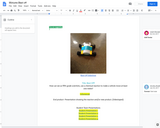
- Subject:
- Mathematics
- Material Type:
- Full Course
- Provider:
- Pearson
- Date Added:
- 11/02/2020


Ratios
Type of Unit: Concept
Prior Knowledge
Students should be able to:
Calculate with whole numbers up to 100 using all four operations.
Understand fraction notation and percents and translate among fractions, decimal numbers, and percents.
Interpret and use a number line.
Use tables to solve problems.
Use tape diagrams to solve problems.
Sketch and interpret graphs.
Write and interpret equations.
Lesson Flow
The first part of the unit begins with an exploration activity that focuses on a ratio as a way to compare the amount of egg and the amount of flour in a mixture. The context motivates a specific understanding of the use of, and need for, ratios as a way of making comparisons between quantities. Following this lesson, the usefulness of ratios in comparing quantities is developed in more detail, including a contrast to using subtraction to find differences. Students learn to interpret and express ratios as fractions, as decimal numbers, in a:b form, in words, and as data; they also learn to identify equivalent ratios.
The focus of the middle part of the unit is on the tools used to represent ratio relationships and on simplifying and comparing ratios. Students learn to use tape diagrams first, then double number lines, and finally ratio tables and graphs. As these tools are introduced, students use them in problem-solving contexts to solve ratio problems, including an investigation of glide ratios. Students are asked to make connections and distinctions among these forms of representation throughout these lessons. Students also choose a ratio project in this part of the unit (Lesson 8).
The third and last part of the unit covers understanding percents, including those greater than 100%.
Students have ample opportunities to check, deepen, and apply their understanding of ratios, including percents, with the selection of problems in the Gallery.

Students are asked to fix a botched mixture that does not follow a given recipe. To fix the mixture, students must find a ratio of eggs to flour that is equivalent to 2:3, but without explicit instruction on the concept of equivalent ratios.Key ConceptsStudents are invited to investigate the underlying idea of equivalent ratios by “correcting” the ratio between two ingredients in a botched mixture that does not follow a given recipe.Goals and Learning ObjectivesExplore a problem based on a recipe with two ingredients.Share approaches, clarify reasoning, and develop clear explanations of how to know a mixture has the right balance of ingredients.

As students are learning about substances, mixtures, and solutions, they will participate in several experiments that involve chemical reactions using regular household products. Some experiments will produce gas or create something that will grow. Students will work in groups of 2-3 students to make a car move using the result of a chemical reaction from combining two or more household substances. They will present their project to the class.

This chapter from the online textbook Everything Science discusses classification of matter and outlines the differences between elements, compounds, and mixtures. Each chapter comes with video lessons and explanations which help bring the ideas and concepts to life.